Abstract
To quantify the effect of the apolipoprotein (apo) E polymorphism on the magnitude of postprandial lipemia, we have defined its role in determining the response to a single high-fat meal in a large sample of (N = 474) individuals taking part in the biethnic Atherosclerosis Risk in Communities Study. The profile of postprandial response in plasma was monitored over 8 h by triglyceride, triglyceride-rich lipoprotein (TGRL)-triglyceride, apo B-48/apo B-100 ratio, and retinyl palmitate concentrations, and the apo E polymorphism was determined by DNA amplification and digestion. The frequency of the apo E alleles and their effects on fasting lipid levels in this sample were similar to those reported elsewhere. Postprandial plasma retinyl palmitate response to a high-fat meal with vitamin A was significantly different among apo E genotypes, with delayed clearance in individuals with an epsilon 2 allele, compared with epsilon 3/3 and epsilon 3/4 individuals. In the sample of 397 Caucasians, average retinyl palmitate response was 1,489 micrograms/dl in epsilon 2/3 individuals, compared with 1,037 micrograms/dl in epsilon 3/3 individuals and 1,108 micrograms/dl in epsilon 3/4 individuals. The apo E polymorphism accounted for 7.1% of the interindividual variation in postprandial retinyl palmitate response, a contribution proportionally greater than its well-known effect on fasting LDL-cholesterol. However, despite this effect on postprandial retinyl palmitate, the profile of postprandial triglyceride response was not significantly different among apo E genotypes. The profile of postprandial response was consistent between the sample of Caucasians and a smaller sample of black subjects. While these data indicate that the removal of remnant particles from circulation is delayed in subjects with the epsilon 2/3 genotype, there is no reported evidence that the epsilon 2 allele predisposes to coronary artery disease (CAD). The results of this study provide not only a reliable estimate of the magnitude of the effect of the apo E polymorphism on various measurements commonly used to characterize postprandial lipemia, but also provide mechanistic insight into the effects of the apo E gene polymorphism on postprandial lipemia and CAD.
Full text
PDF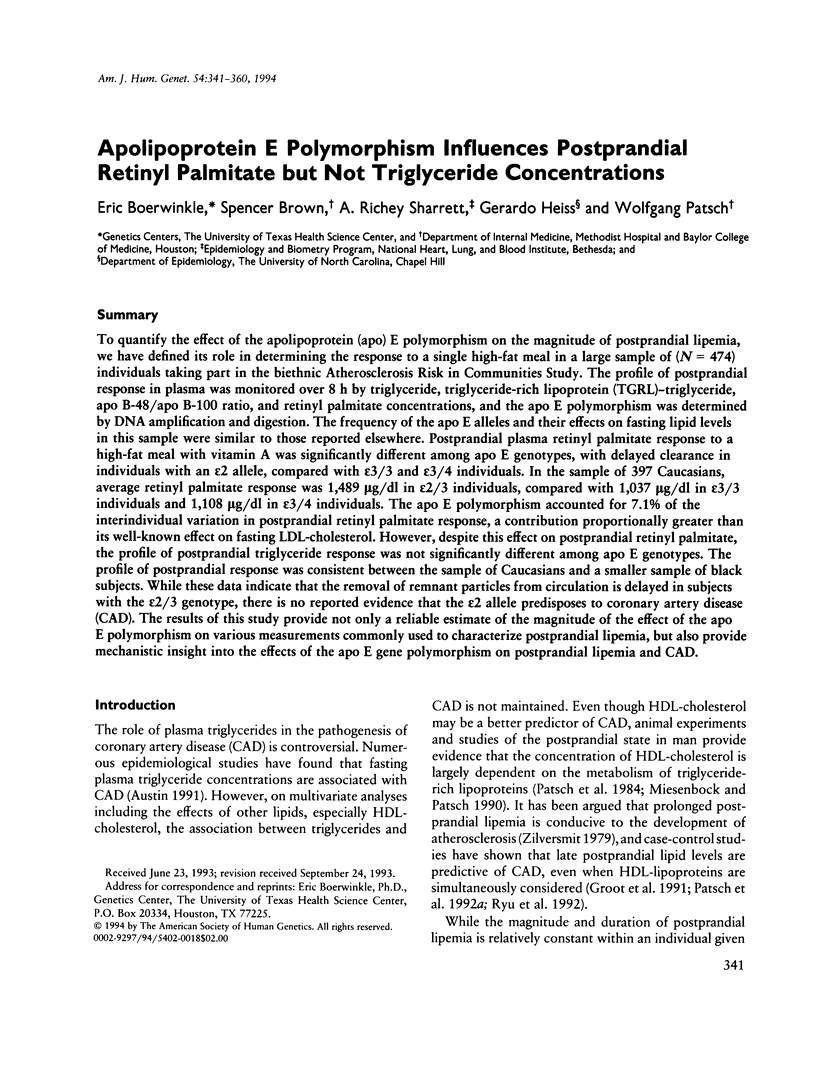
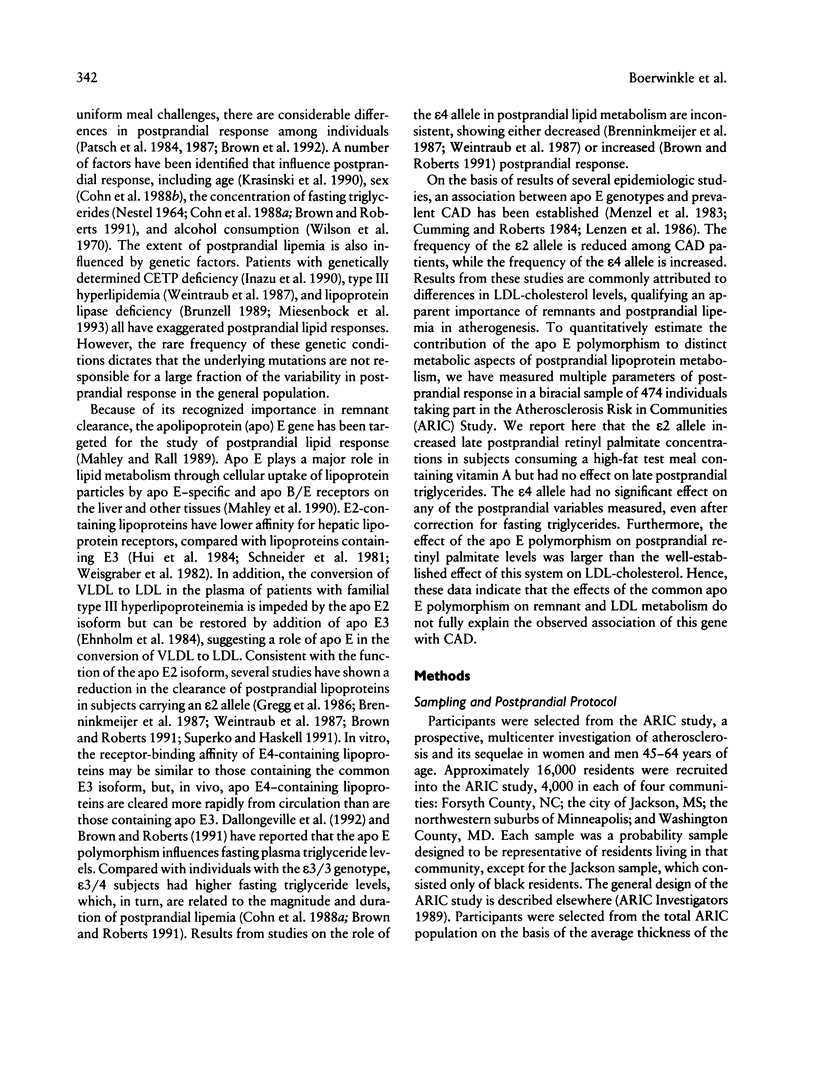
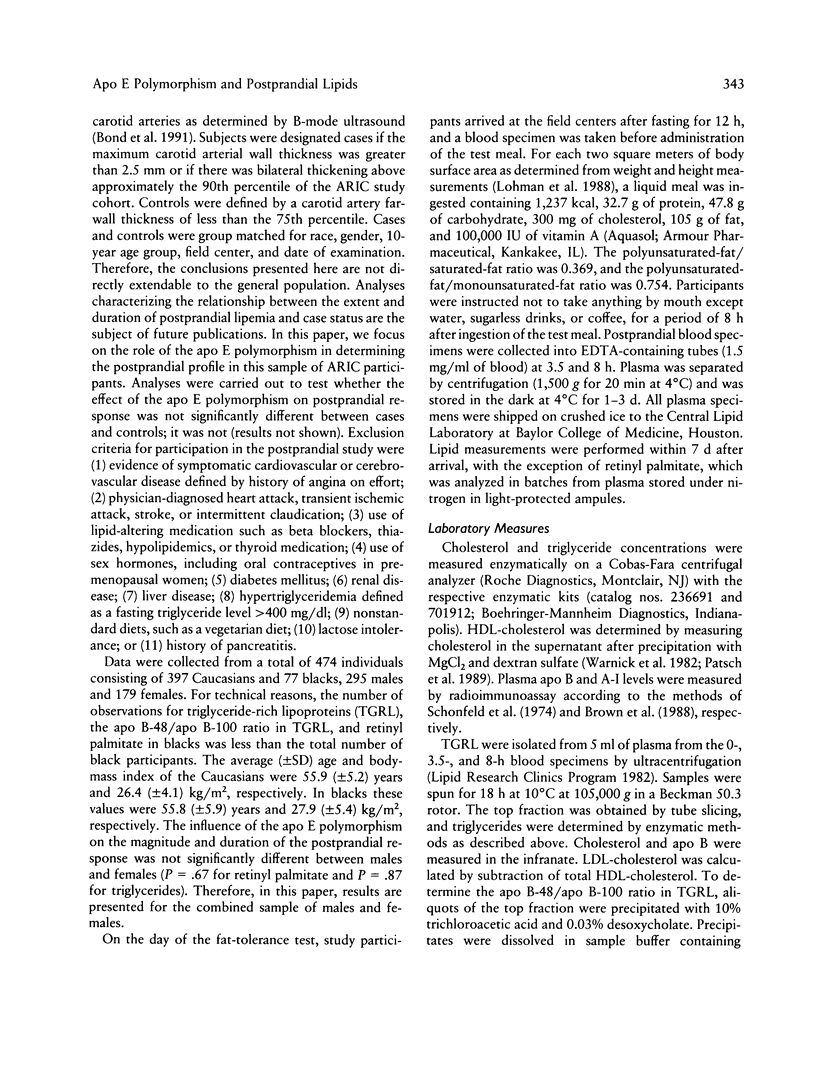
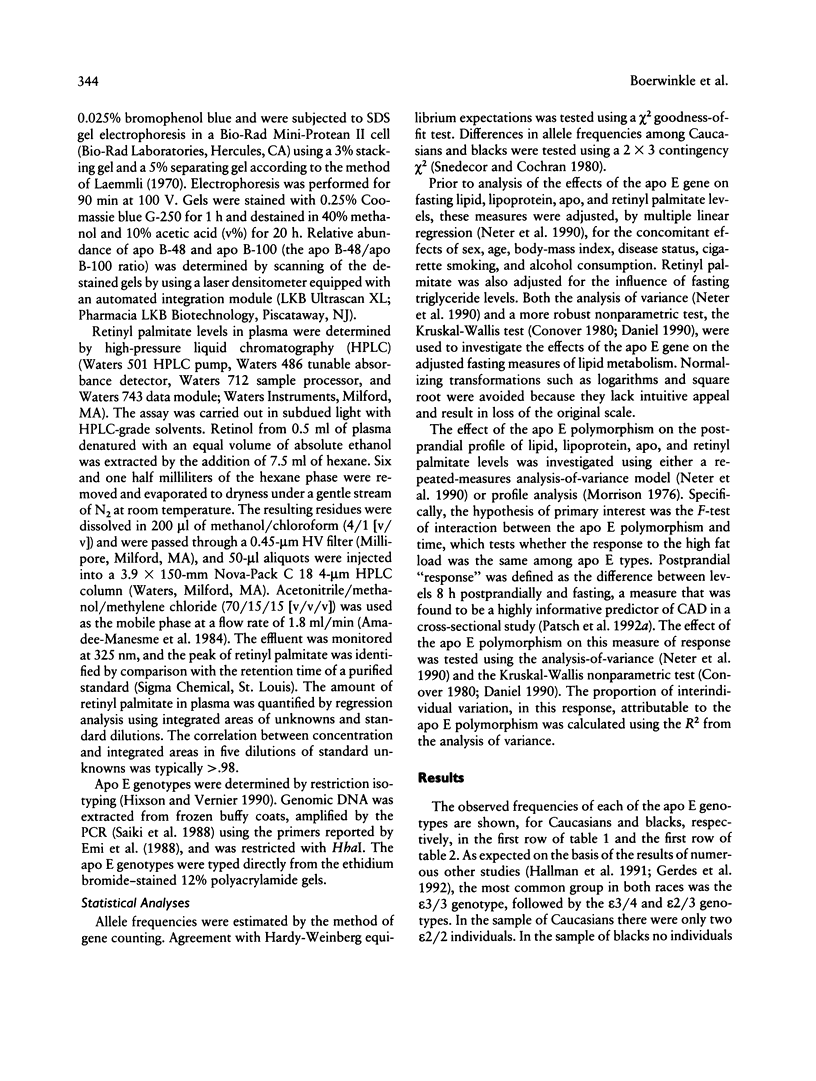
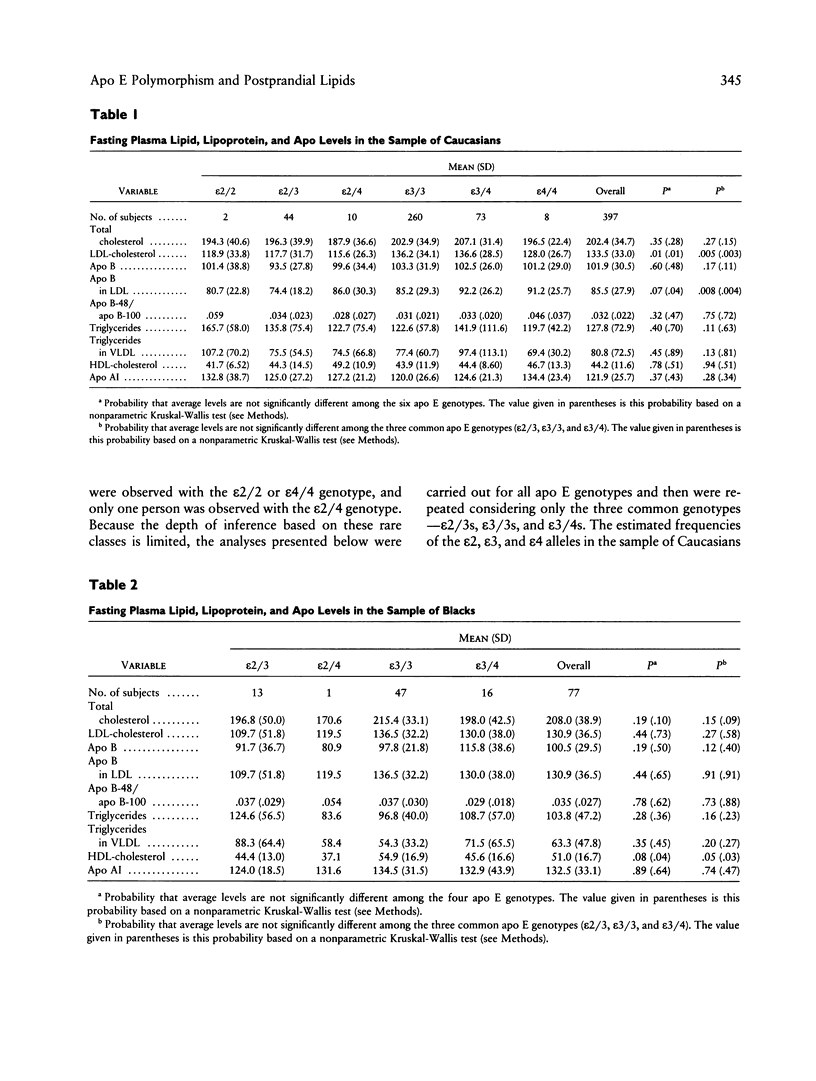
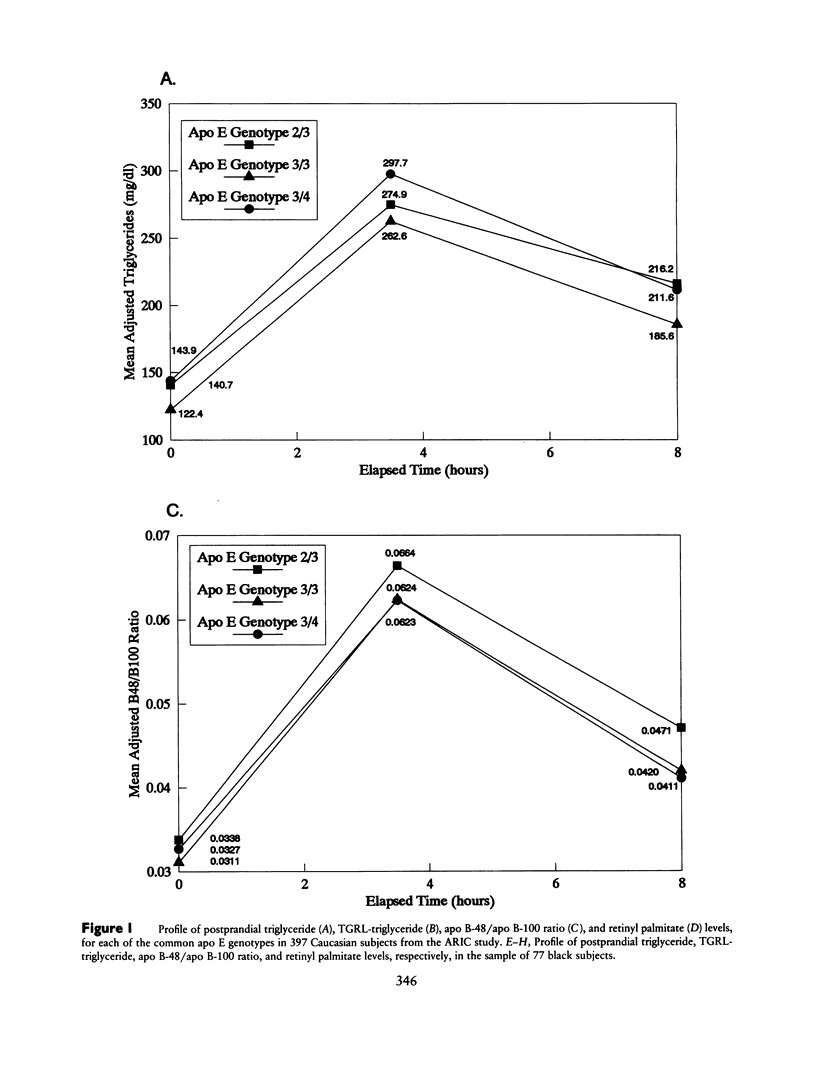
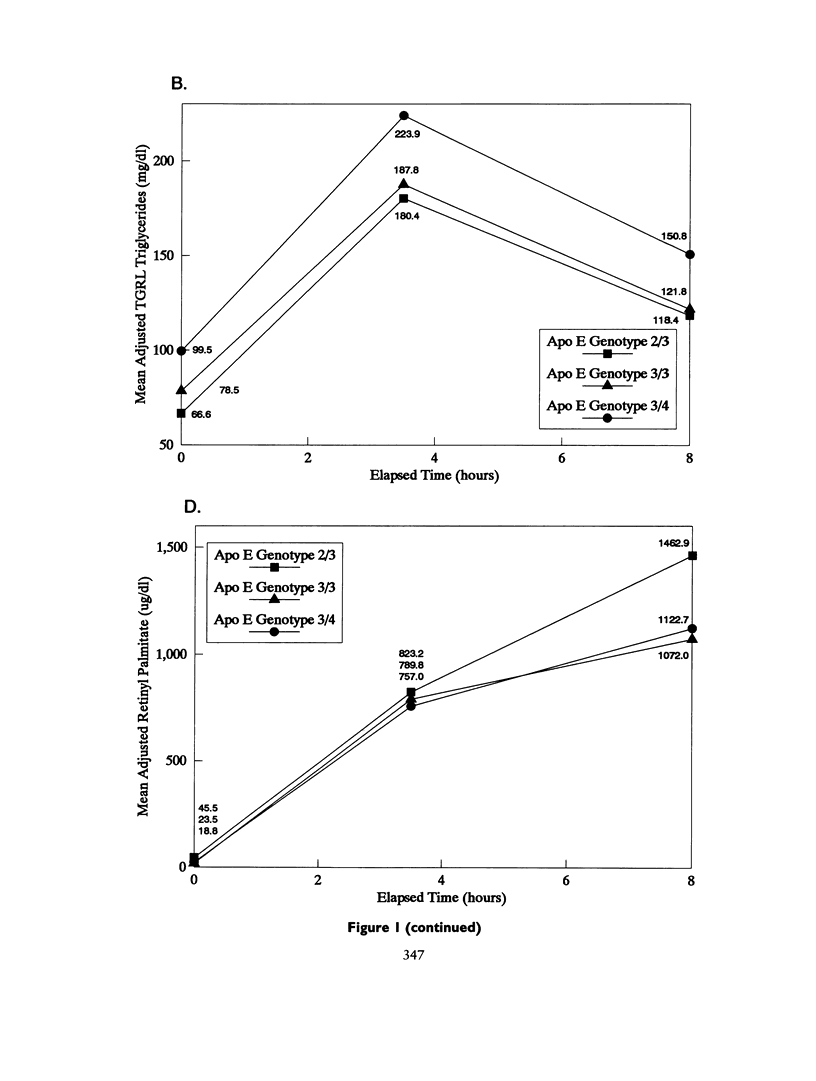
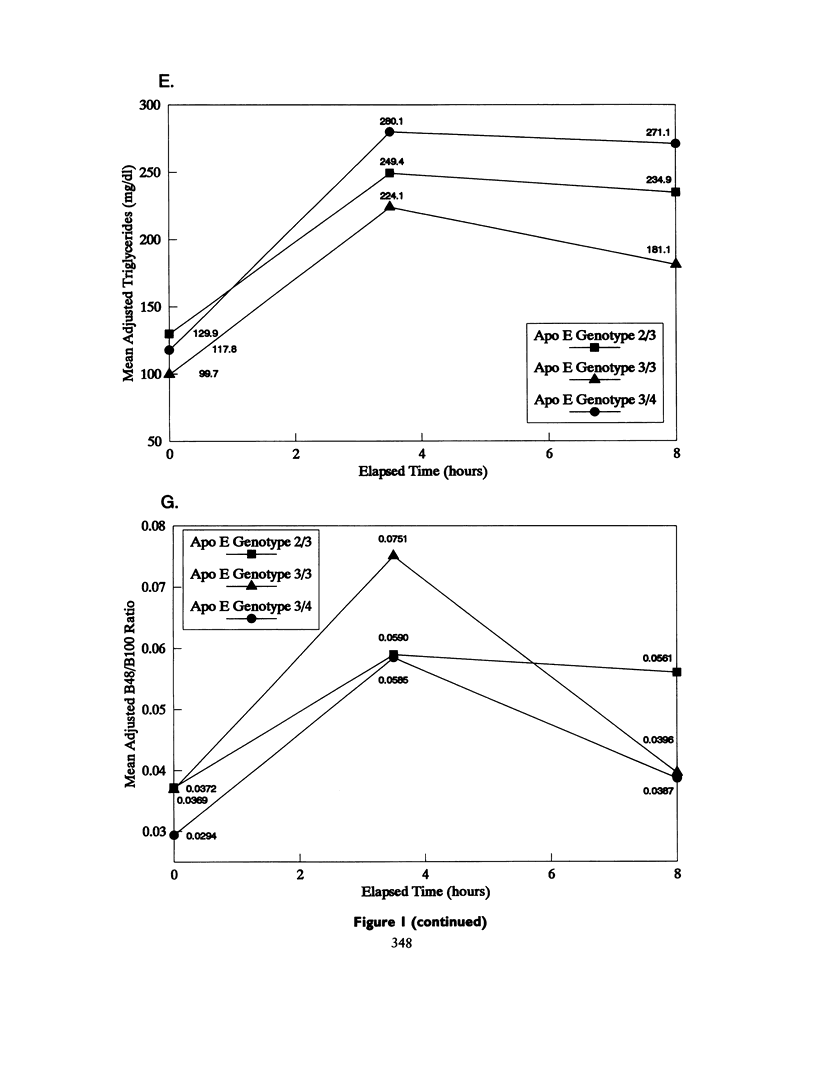
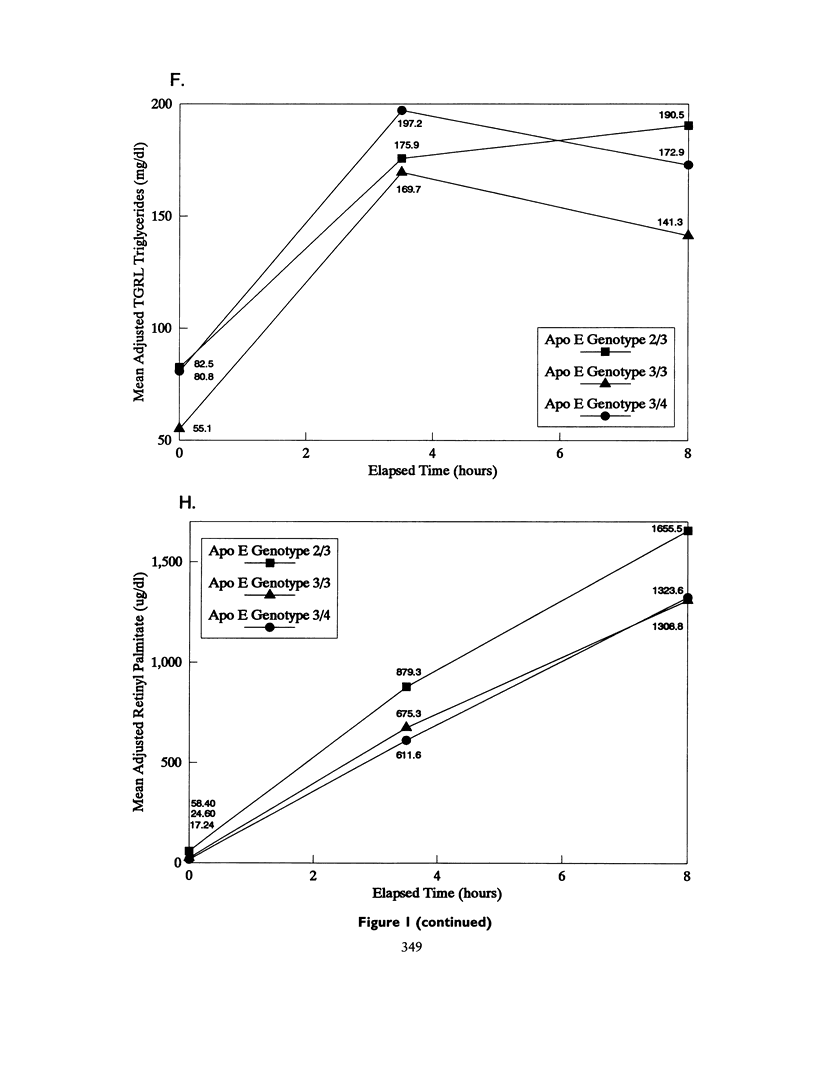
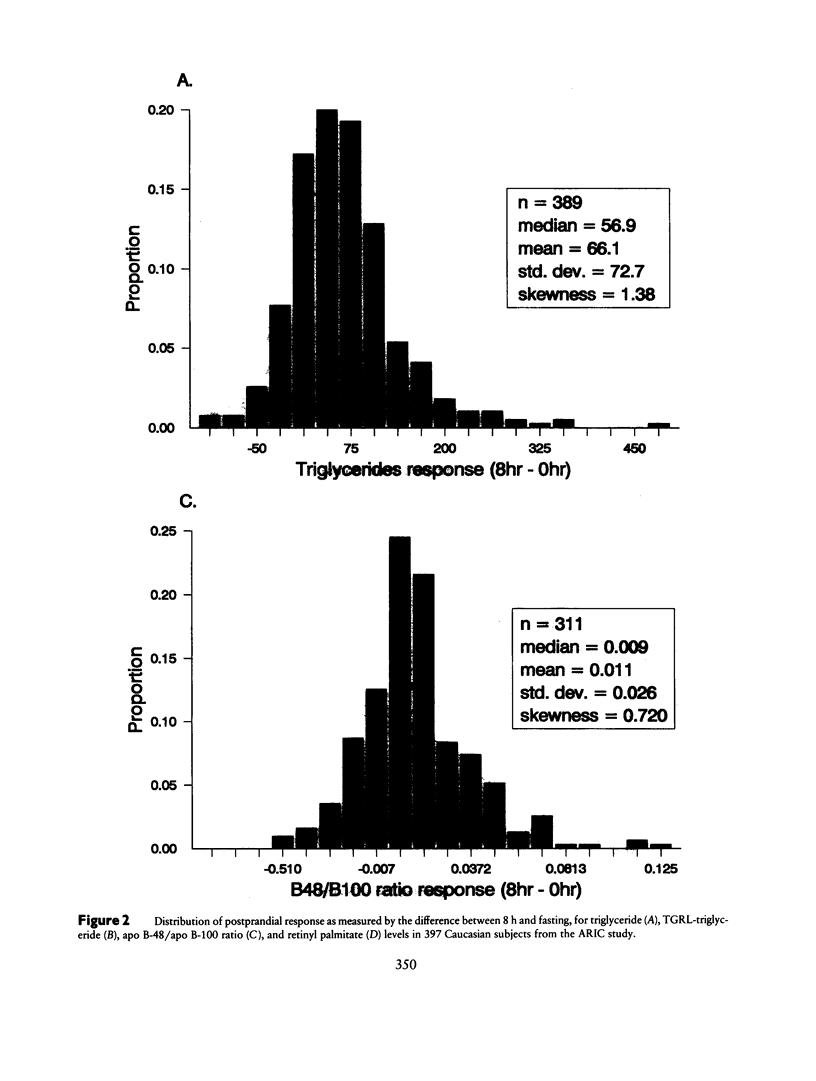
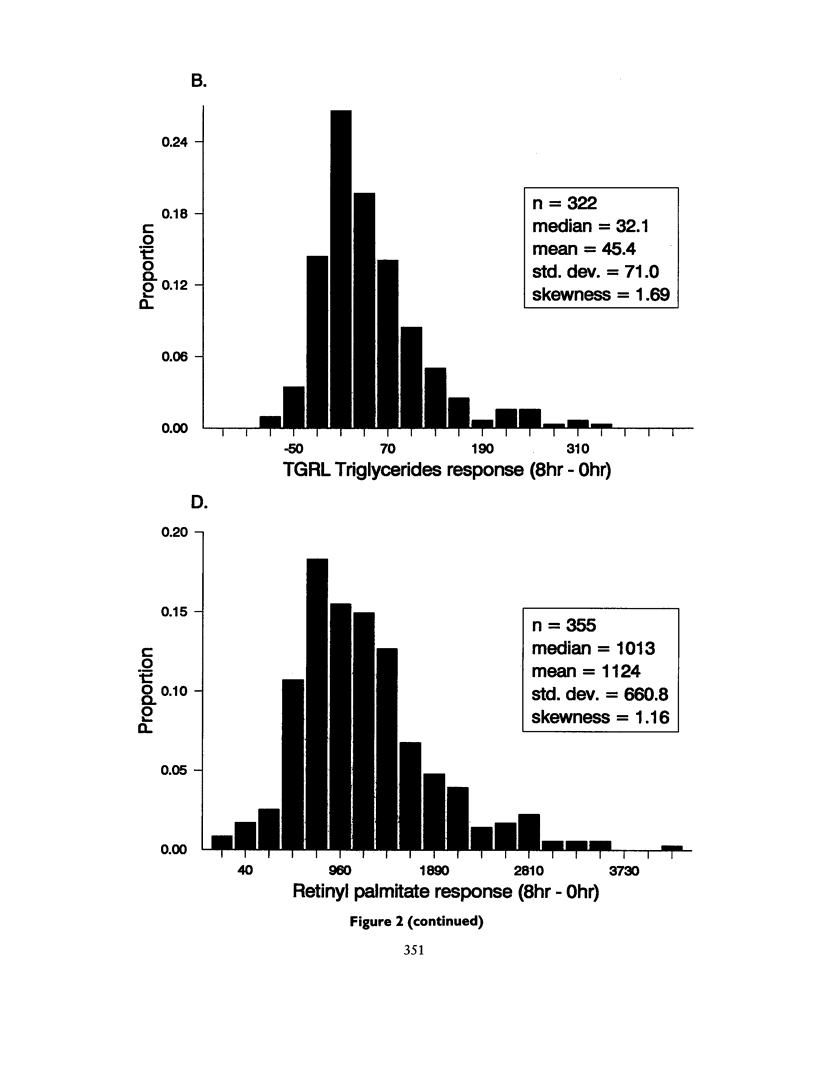
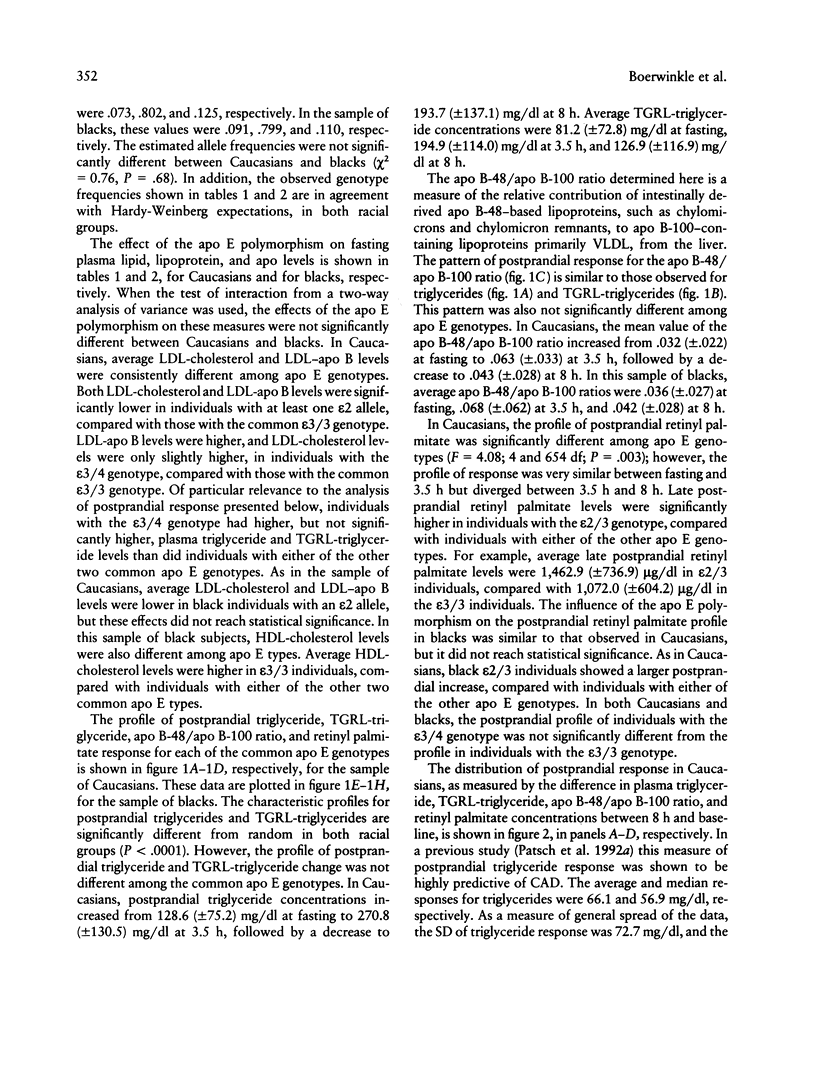
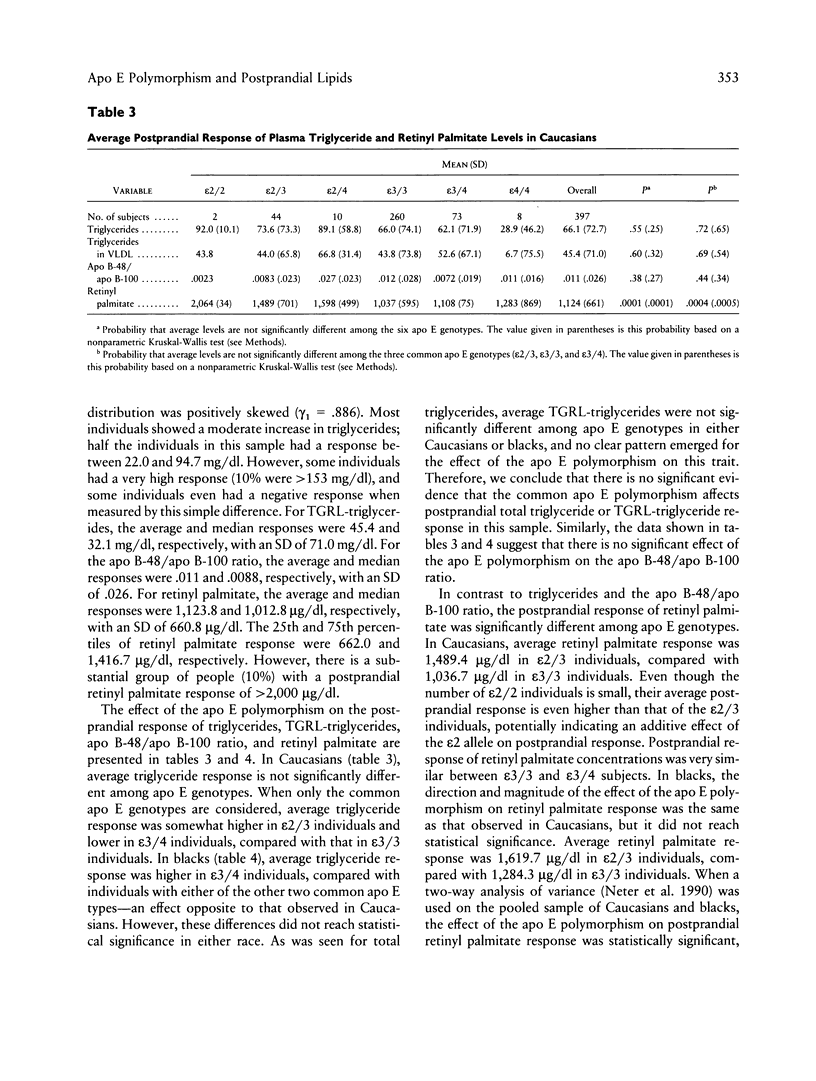
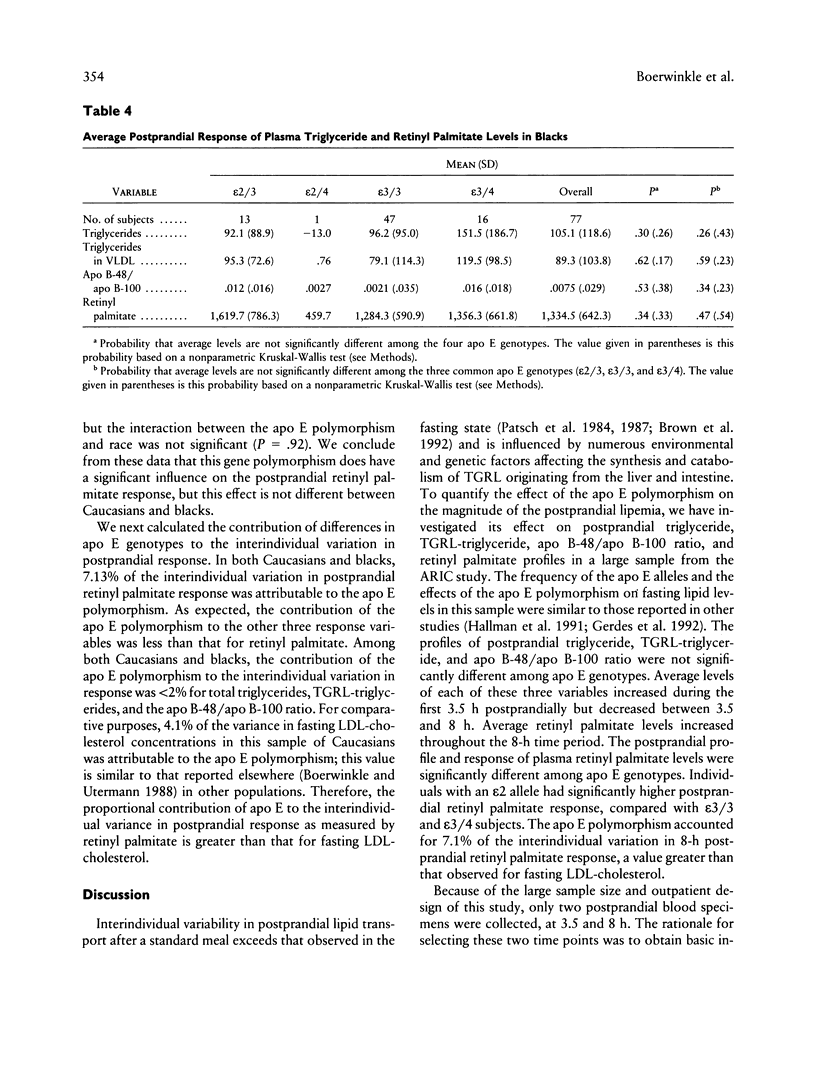
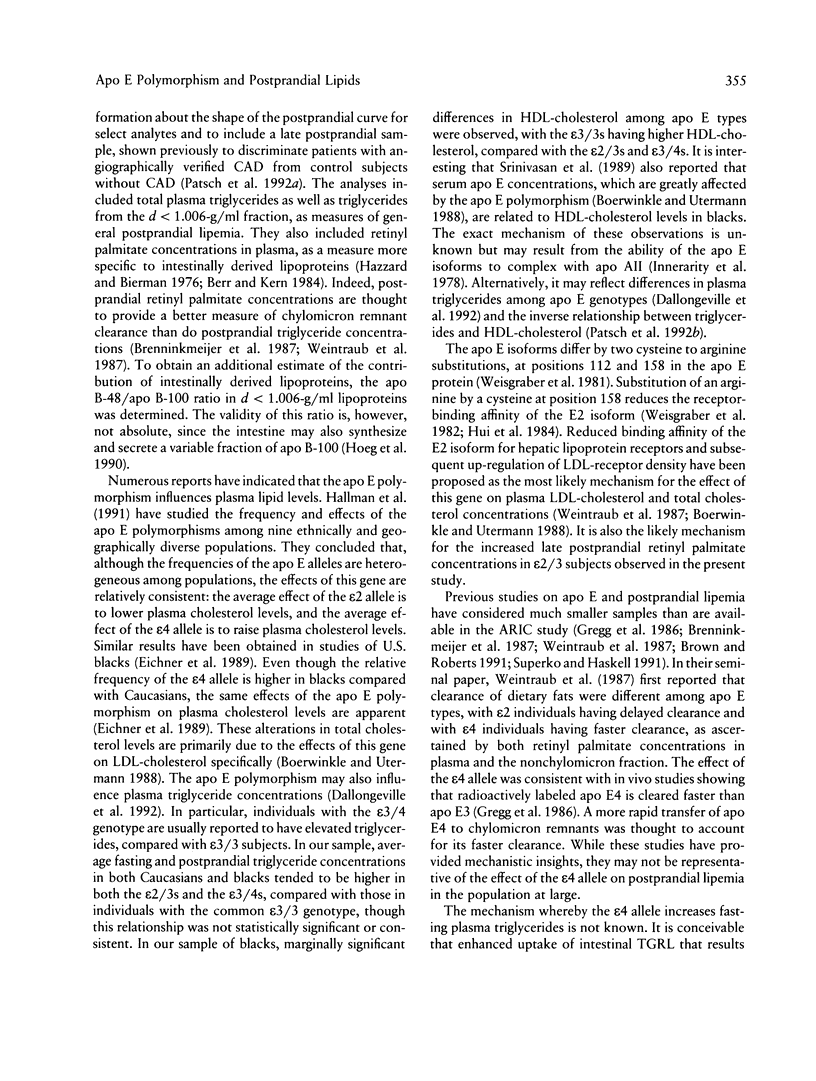
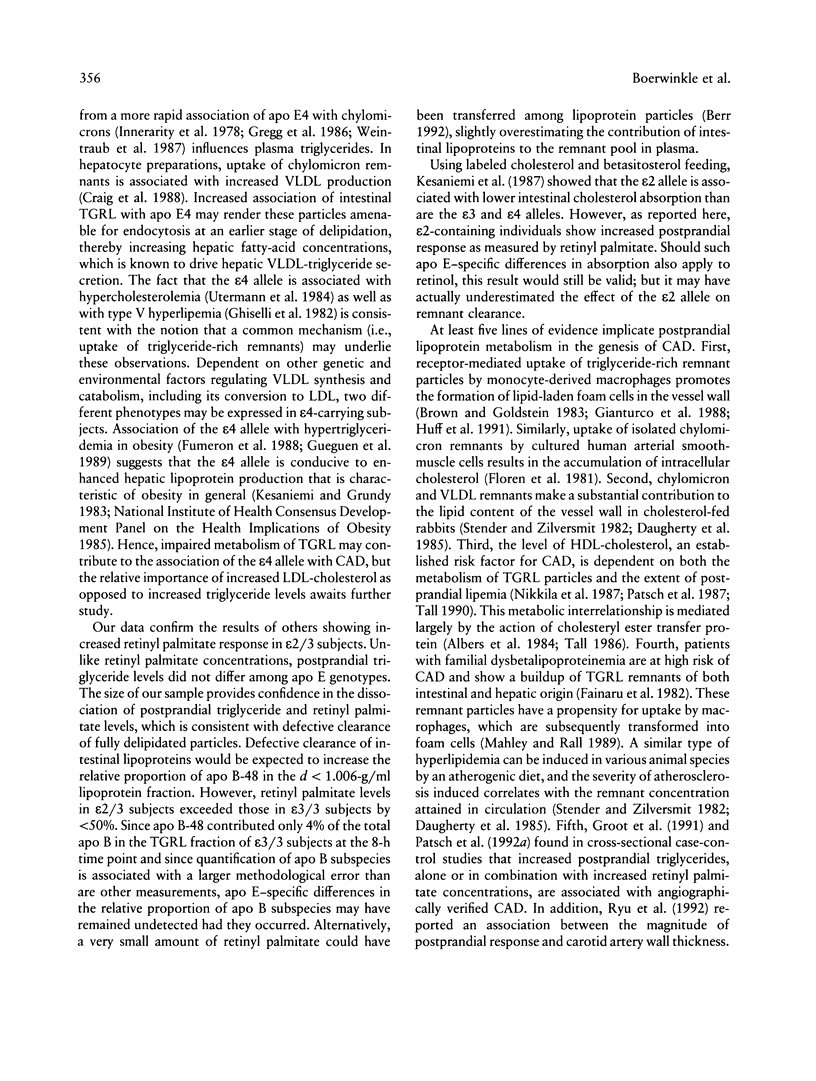
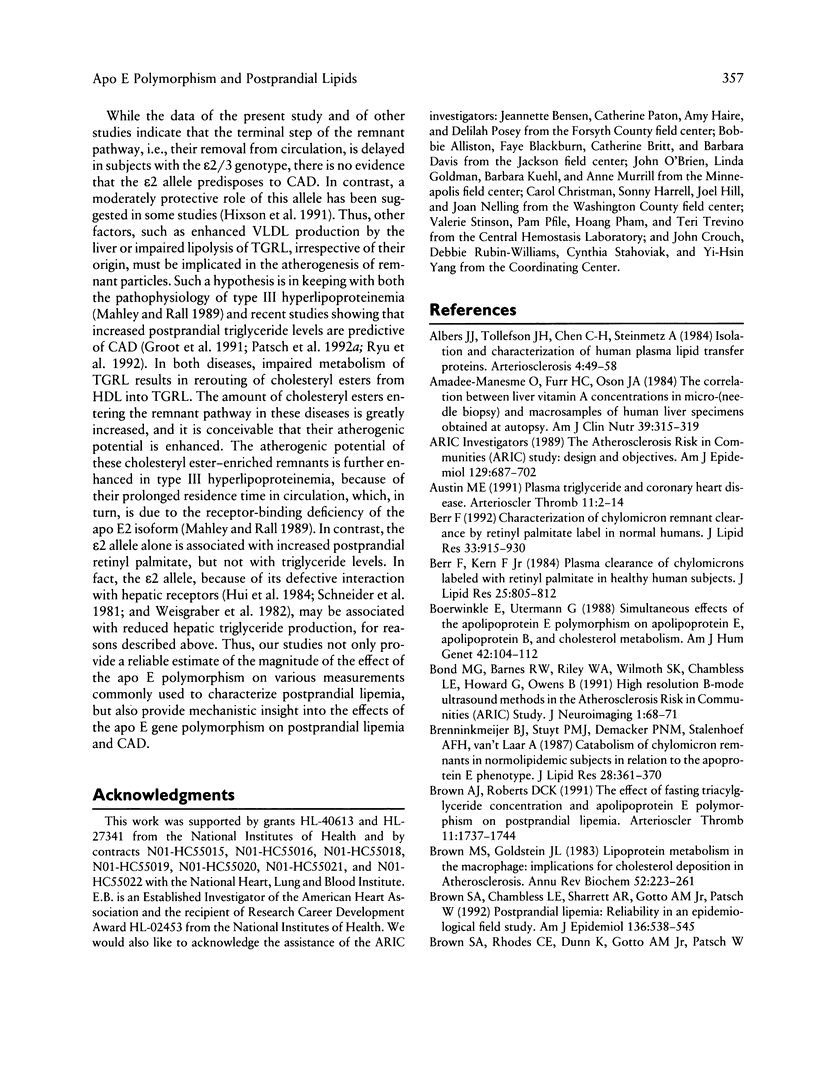
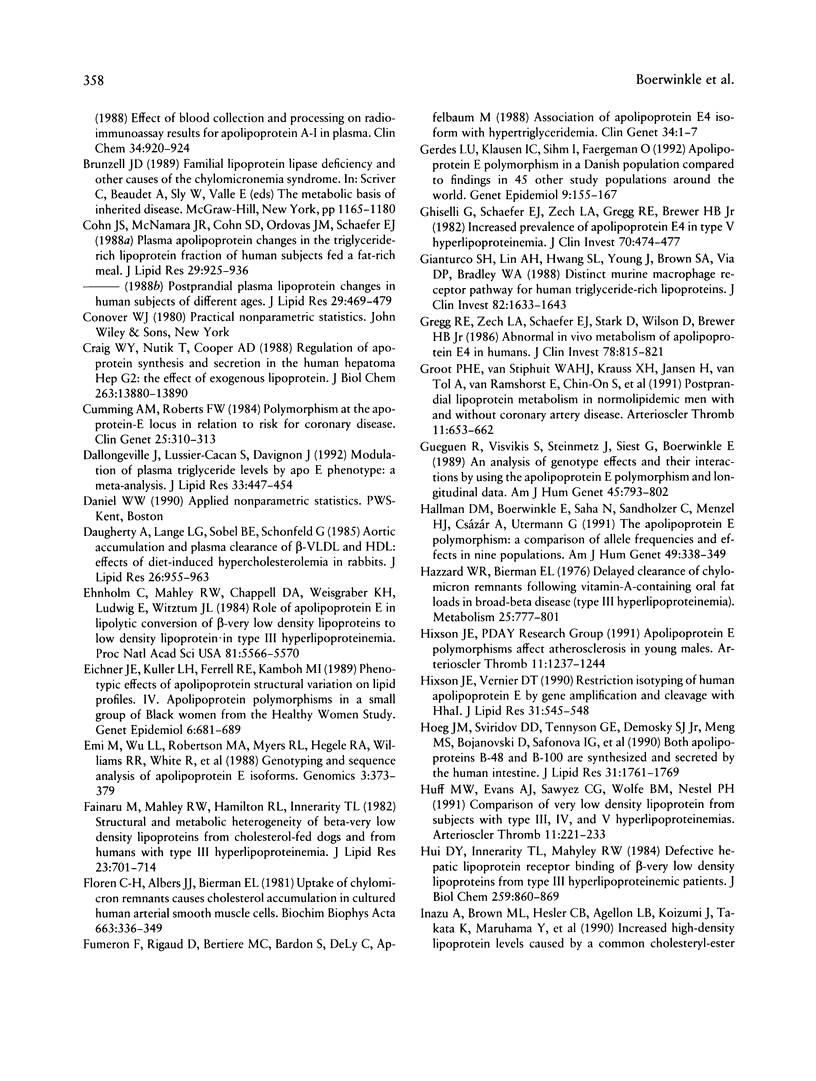
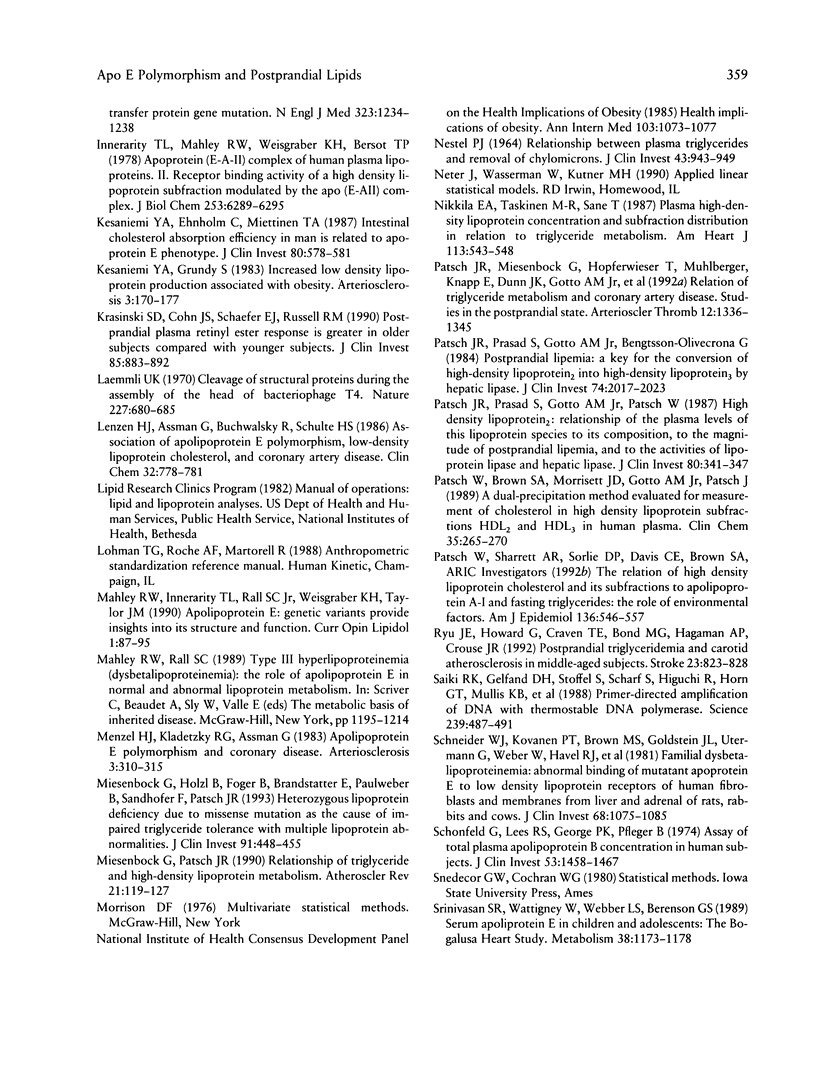
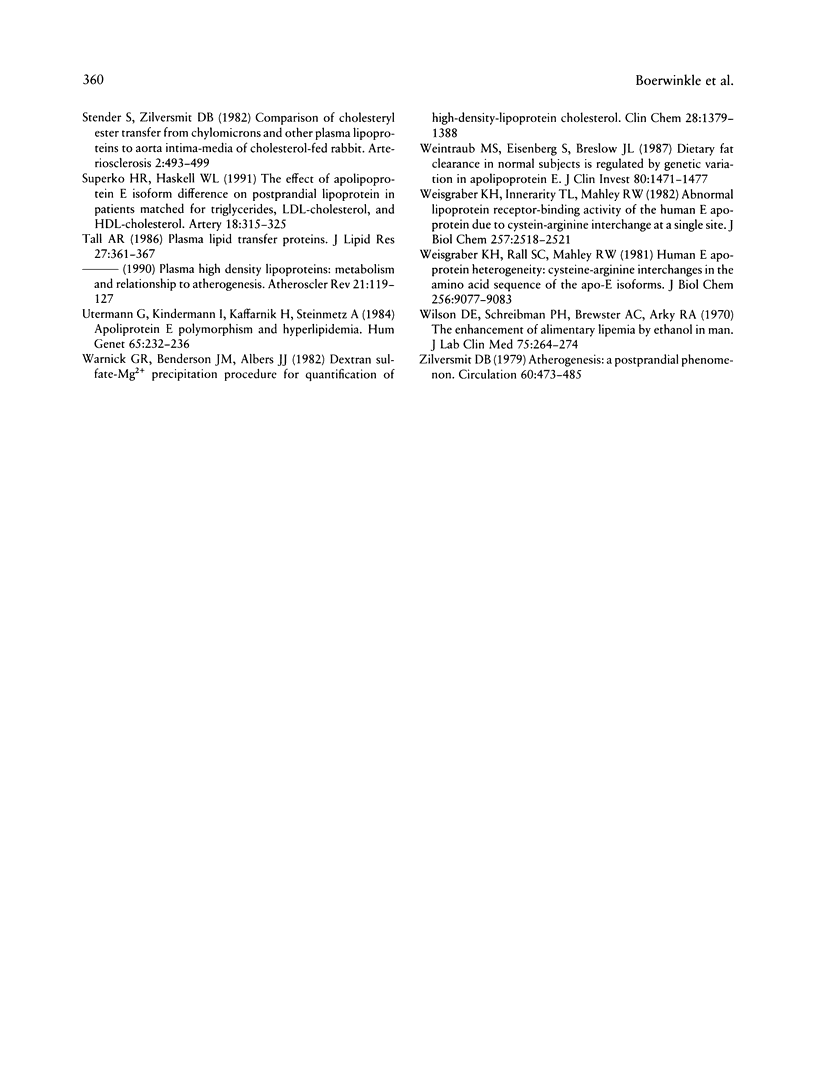
Selected References
These references are in PubMed. This may not be the complete list of references from this article.
- Albers J. J., Tollefson J. H., Chen C. H., Steinmetz A. Isolation and characterization of human plasma lipid transfer proteins. Arteriosclerosis. 1984 Jan-Feb;4(1):49–58. doi: 10.1161/01.atv.4.1.49. [DOI] [PubMed] [Google Scholar]
- Amédée-Manesme O., Furr H. C., Olson J. A. The correlation between liver vitamin A concentrations in micro- (needle biopsy) and macrosamples of human liver specimens obtained at autopsy. Am J Clin Nutr. 1984 Feb;39(2):315–319. doi: 10.1093/ajcn/39.2.315. [DOI] [PubMed] [Google Scholar]
- Austin M. A. Plasma triglyceride and coronary heart disease. Arterioscler Thromb. 1991 Jan-Feb;11(1):2–14. doi: 10.1161/01.atv.11.1.2. [DOI] [PubMed] [Google Scholar]
- Berr F. Characterization of chylomicron remnant clearance by retinyl palmitate label in normal humans. J Lipid Res. 1992 Jun;33(6):915–930. [PubMed] [Google Scholar]
- Berr F., Kern F., Jr Plasma clearance of chylomicrons labeled with retinyl palmitate in healthy human subjects. J Lipid Res. 1984 Aug;25(8):805–812. [PubMed] [Google Scholar]
- Boerwinkle E., Utermann G. Simultaneous effects of the apolipoprotein E polymorphism on apolipoprotein E, apolipoprotein B, and cholesterol metabolism. Am J Hum Genet. 1988 Jan;42(1):104–112. [PMC free article] [PubMed] [Google Scholar]
- Brenninkmeijer B. J., Stuyt P. M., Demacker P. N., Stalenhoef A. F., van 't Laar A. Catabolism of chylomicron remnants in normolipidemic subjects in relation to the apoprotein E phenotype. J Lipid Res. 1987 Apr;28(4):361–370. [PubMed] [Google Scholar]
- Brown A. J., Roberts D. C. The effect of fasting triacylglyceride concentration and apolipoprotein E polymorphism on postprandial lipemia. Arterioscler Thromb. 1991 Nov-Dec;11(6):1737–1744. doi: 10.1161/01.atv.11.6.1737. [DOI] [PubMed] [Google Scholar]
- Brown M. S., Goldstein J. L. Lipoprotein metabolism in the macrophage: implications for cholesterol deposition in atherosclerosis. Annu Rev Biochem. 1983;52:223–261. doi: 10.1146/annurev.bi.52.070183.001255. [DOI] [PubMed] [Google Scholar]
- Brown S. A., Chambless L. E., Sharrett A. R., Gotto A. M., Jr, Patsch W. Postprandial lipemia: reliability in an epidemiologic field study. Am J Epidemiol. 1992 Sep 1;136(5):538–545. doi: 10.1093/oxfordjournals.aje.a116531. [DOI] [PubMed] [Google Scholar]
- Cohn J. S., McNamara J. R., Cohn S. D., Ordovas J. M., Schaefer E. J. Plasma apolipoprotein changes in the triglyceride-rich lipoprotein fraction of human subjects fed a fat-rich meal. J Lipid Res. 1988 Jul;29(7):925–936. [PubMed] [Google Scholar]
- Craig W. Y., Nutik R., Cooper A. D. Regulation of apoprotein synthesis and secretion in the human hepatoma Hep G2. The effect of exogenous lipoprotein. J Biol Chem. 1988 Sep 25;263(27):13880–13890. [PubMed] [Google Scholar]
- Cumming A. M., Robertson F. W. Polymorphism at the apoprotein-E locus in relation to risk of coronary disease. Clin Genet. 1984 Apr;25(4):310–313. doi: 10.1111/j.1399-0004.1984.tb01995.x. [DOI] [PubMed] [Google Scholar]
- Dallongeville J., Lussier-Cacan S., Davignon J. Modulation of plasma triglyceride levels by apoE phenotype: a meta-analysis. J Lipid Res. 1992 Apr;33(4):447–454. [PubMed] [Google Scholar]
- Daugherty A., Lange L. G., Sobel B. E., Schonfeld G. Aortic accumulation and plasma clearance of beta-VLDL and HDL: effects of diet-induced hypercholesterolemia in rabbits. J Lipid Res. 1985 Aug;26(8):955–963. [PubMed] [Google Scholar]
- Ehnholm C., Mahley R. W., Chappell D. A., Weisgraber K. H., Ludwig E., Witztum J. L. Role of apolipoprotein E in the lipolytic conversion of beta-very low density lipoproteins to low density lipoproteins in type III hyperlipoproteinemia. Proc Natl Acad Sci U S A. 1984 Sep;81(17):5566–5570. doi: 10.1073/pnas.81.17.5566. [DOI] [PMC free article] [PubMed] [Google Scholar]
- Eichner J. E., Kuller L. H., Ferrell R. E., Kamboh M. I. Phenotypic effects of apolipoprotein structural variation on lipid profiles. IV. Apolipoprotein polymorphisms in a small group of black women from the healthy women study. Genet Epidemiol. 1989;6(6):681–689. doi: 10.1002/gepi.1370060605. [DOI] [PubMed] [Google Scholar]
- Emi M., Wu L. L., Robertson M. A., Myers R. L., Hegele R. A., Williams R. R., White R., Lalouel J. M. Genotyping and sequence analysis of apolipoprotein E isoforms. Genomics. 1988 Nov;3(4):373–379. doi: 10.1016/0888-7543(88)90130-9. [DOI] [PubMed] [Google Scholar]
- Fainaru M., Mahley R. W., Hamilton R. L., Innerarity T. L. Structural and metabolic heterogeneity of beta-very low density lipoproteins from cholesterol-fed dogs and from humans with type III hyperlipoproteinemia. J Lipid Res. 1982 Jul;23(5):702–714. [PubMed] [Google Scholar]
- Florén C. H., Albers J. J., Bierman E. L. Uptake of chylomicron remnants causes cholesterol accumulation in cultured human arterial smooth muscle cells. Biochim Biophys Acta. 1981 Jan 26;663(1):336–349. doi: 10.1016/0005-2760(81)90219-8. [DOI] [PubMed] [Google Scholar]
- Gerdes L. U., Klausen I. C., Sihm I., Faergeman O. Apolipoprotein E polymorphism in a Danish population compared to findings in 45 other study populations around the world. Genet Epidemiol. 1992;9(3):155–167. doi: 10.1002/gepi.1370090302. [DOI] [PubMed] [Google Scholar]
- Ghiselli G., Schaefer E. J., Zech L. A., Gregg R. E., Brewer H. B., Jr Increased prevalence of apolipoprotein E4 in type V hyperlipoproteinemia. J Clin Invest. 1982 Aug;70(2):474–477. doi: 10.1172/JCI110638. [DOI] [PMC free article] [PubMed] [Google Scholar]
- Gianturco S. H., Lin A. H., Hwang S. L., Young J., Brown S. A., Via D. P., Bradley W. A. Distinct murine macrophage receptor pathway for human triglyceride-rich lipoproteins. J Clin Invest. 1988 Nov;82(5):1633–1643. doi: 10.1172/JCI113775. [DOI] [PMC free article] [PubMed] [Google Scholar]
- Gregg R. E., Zech L. A., Schaefer E. J., Stark D., Wilson D., Brewer H. B., Jr Abnormal in vivo metabolism of apolipoprotein E4 in humans. J Clin Invest. 1986 Sep;78(3):815–821. doi: 10.1172/JCI112645. [DOI] [PMC free article] [PubMed] [Google Scholar]
- Groot P. H., van Stiphout W. A., Krauss X. H., Jansen H., van Tol A., van Ramshorst E., Chin-On S., Hofman A., Cresswell S. R., Havekes L. Postprandial lipoprotein metabolism in normolipidemic men with and without coronary artery disease. Arterioscler Thromb. 1991 May-Jun;11(3):653–662. doi: 10.1161/01.atv.11.3.653. [DOI] [PubMed] [Google Scholar]
- Gueguen R., Visvikis S., Steinmetz J., Siest G., Boerwinkle E. An analysis of genotype effects and their interactions by using the apolipoprotein E polymorphism and longitudinal data. Am J Hum Genet. 1989 Nov;45(5):793–802. [PMC free article] [PubMed] [Google Scholar]
- Hallman D. M., Boerwinkle E., Saha N., Sandholzer C., Menzel H. J., Csázár A., Utermann G. The apolipoprotein E polymorphism: a comparison of allele frequencies and effects in nine populations. Am J Hum Genet. 1991 Aug;49(2):338–349. [PMC free article] [PubMed] [Google Scholar]
- Harris A., Lankester S., Haan E., Beres J., Hulten M., Szollar J., Souttier L., Bobrow M. The gene for incontinentia pigmenti: failure of linkage studies using DNA probes to confirm cytogenetic localization. Clin Genet. 1988 Jul;34(1):1–6. doi: 10.1111/j.1399-0004.1988.tb02607.x. [DOI] [PubMed] [Google Scholar]
- Hazzard W. R., Bierman E. L. Delayed clearance of chylomicron remnants following vitamin-A-containing oral fat loads in broad-beta disease (type III hyperlipoproteinemia). Metabolism. 1976 Jul;25(7):777–801. doi: 10.1016/0026-0495(76)90149-9. [DOI] [PubMed] [Google Scholar]
- High-resolution B-mode ultrasound scanning methods in the Atherosclerosis Risk in Communities Study (ARIC). The ARIC Study Group. J Neuroimaging. 1991 May;1(2):68–73. [PubMed] [Google Scholar]
- Hixson J. E. Apolipoprotein E polymorphisms affect atherosclerosis in young males. Pathobiological Determinants of Atherosclerosis in Youth (PDAY) Research Group. Arterioscler Thromb. 1991 Sep-Oct;11(5):1237–1244. doi: 10.1161/01.atv.11.5.1237. [DOI] [PubMed] [Google Scholar]
- Hixson J. E., Vernier D. T. Restriction isotyping of human apolipoprotein E by gene amplification and cleavage with HhaI. J Lipid Res. 1990 Mar;31(3):545–548. [PubMed] [Google Scholar]
- Hoeg J. M., Sviridov D. D., Tennyson G. E., Demosky S. J., Jr, Meng M. S., Bojanovski D., Safonova I. G., Repin V. S., Kuberger M. B., Smirnov V. N. Both apolipoproteins B-48 and B-100 are synthesized and secreted by the human intestine. J Lipid Res. 1990 Oct;31(10):1761–1769. [PubMed] [Google Scholar]
- Huff M. W., Evans A. J., Sawyez C. G., Wolfe B. M., Nestel P. J. Cholesterol accumulation in J774 macrophages induced by triglyceride-rich lipoproteins. Comparison of very low density lipoprotein from subjects with type III, IV, and V hyperlipoproteinemias. Arterioscler Thromb. 1991 Mar-Apr;11(2):221–233. doi: 10.1161/01.atv.11.2.221. [DOI] [PubMed] [Google Scholar]
- Hui D. Y., Innerarity T. L., Mahley R. W. Defective hepatic lipoprotein receptor binding of beta-very low density lipoproteins from type III hyperlipoproteinemic patients. Importance of apolipoprotein E. J Biol Chem. 1984 Jan 25;259(2):860–869. [PubMed] [Google Scholar]
- Inazu A., Brown M. L., Hesler C. B., Agellon L. B., Koizumi J., Takata K., Maruhama Y., Mabuchi H., Tall A. R. Increased high-density lipoprotein levels caused by a common cholesteryl-ester transfer protein gene mutation. N Engl J Med. 1990 Nov 1;323(18):1234–1238. doi: 10.1056/NEJM199011013231803. [DOI] [PubMed] [Google Scholar]
- Innerarity T. L., Mahley R. W., Weisgraber K. H., Bersot T. P. Apoprotein (E--A-II) complex of human plasma lipoproteins. II. Receptor binding activity of a high density lipoprotein subfraction modulated by the apo(E--A-II) complex. J Biol Chem. 1978 Sep 10;253(17):6289–6295. [PubMed] [Google Scholar]
- Kesaniemi Y. A., Grundy S. M. Increased low density lipoprotein production associated with obesity. Arteriosclerosis. 1983 Mar-Apr;3(2):170–177. doi: 10.1161/01.atv.3.2.170. [DOI] [PubMed] [Google Scholar]
- Kesäniemi Y. A., Ehnholm C., Miettinen T. A. Intestinal cholesterol absorption efficiency in man is related to apoprotein E phenotype. J Clin Invest. 1987 Aug;80(2):578–581. doi: 10.1172/JCI113107. [DOI] [PMC free article] [PubMed] [Google Scholar]
- Krasinski S. D., Cohn J. S., Schaefer E. J., Russell R. M. Postprandial plasma retinyl ester response is greater in older subjects compared with younger subjects. Evidence for delayed plasma clearance of intestinal lipoproteins. J Clin Invest. 1990 Mar;85(3):883–892. doi: 10.1172/JCI114515. [DOI] [PMC free article] [PubMed] [Google Scholar]
- Laemmli U. K. Cleavage of structural proteins during the assembly of the head of bacteriophage T4. Nature. 1970 Aug 15;227(5259):680–685. doi: 10.1038/227680a0. [DOI] [PubMed] [Google Scholar]
- Lenzen H. J., Assmann G., Buchwalsky R., Schulte H. Association of apolipoprotein E polymorphism, low-density lipoprotein cholesterol, and coronary artery disease. Clin Chem. 1986 May;32(5):778–781. [PubMed] [Google Scholar]
- Menzel H. J., Kladetzky R. G., Assmann G. Apolipoprotein E polymorphism and coronary artery disease. Arteriosclerosis. 1983 Jul-Aug;3(4):310–315. doi: 10.1161/01.atv.3.4.310. [DOI] [PubMed] [Google Scholar]
- Miesenböck G., Hölzl B., Föger B., Brandstätter E., Paulweber B., Sandhofer F., Patsch J. R. Heterozygous lipoprotein lipase deficiency due to a missense mutation as the cause of impaired triglyceride tolerance with multiple lipoprotein abnormalities. J Clin Invest. 1993 Feb;91(2):448–455. doi: 10.1172/JCI116222. [DOI] [PMC free article] [PubMed] [Google Scholar]
- NESTEL P. J. RELATIONSHIP BETWEEN PLASMA TRIGLYCERIDES AND REMOVAL OF CHYLOMICRONS. J Clin Invest. 1964 May;43:943–949. doi: 10.1172/JCI104980. [DOI] [PMC free article] [PubMed] [Google Scholar]
- Patsch J. R., Miesenböck G., Hopferwieser T., Mühlberger V., Knapp E., Dunn J. K., Gotto A. M., Jr, Patsch W. Relation of triglyceride metabolism and coronary artery disease. Studies in the postprandial state. Arterioscler Thromb. 1992 Nov;12(11):1336–1345. doi: 10.1161/01.atv.12.11.1336. [DOI] [PubMed] [Google Scholar]
- Patsch J. R., Prasad S., Gotto A. M., Jr, Bengtsson-Olivecrona G. Postprandial lipemia. A key for the conversion of high density lipoprotein2 into high density lipoprotein3 by hepatic lipase. J Clin Invest. 1984 Dec;74(6):2017–2023. doi: 10.1172/JCI111624. [DOI] [PMC free article] [PubMed] [Google Scholar]
- Patsch J. R., Prasad S., Gotto A. M., Jr, Patsch W. High density lipoprotein2. Relationship of the plasma levels of this lipoprotein species to its composition, to the magnitude of postprandial lipemia, and to the activities of lipoprotein lipase and hepatic lipase. J Clin Invest. 1987 Aug;80(2):341–347. doi: 10.1172/JCI113078. [DOI] [PMC free article] [PubMed] [Google Scholar]
- Patsch W., Brown S. A., Morrisett J. D., Gotto A. M., Jr, Patsch J. R. A dual-precipitation method evaluated for measurement of cholesterol in high-density lipoprotein subfractions HDL2 and HDL3 in human plasma. Clin Chem. 1989 Feb;35(2):265–270. [PubMed] [Google Scholar]
- Patsch W., Sharrett A. R., Sorlie P. D., Davis C. E., Brown S. A. The relation of high density lipoprotein cholesterol and its subfractions to apolipoprotein A-I and fasting triglycerides: the role of environmental factors. The Atherosclerosis Risk in Communities (ARIC) Study. Am J Epidemiol. 1992 Sep 1;136(5):546–557. doi: 10.1093/oxfordjournals.aje.a116532. [DOI] [PubMed] [Google Scholar]
- Ryu J. E., Howard G., Craven T. E., Bond M. G., Hagaman A. P., Crouse J. R., 3rd Postprandial triglyceridemia and carotid atherosclerosis in middle-aged subjects. Stroke. 1992 Jun;23(6):823–828. doi: 10.1161/01.str.23.6.823. [DOI] [PubMed] [Google Scholar]
- Saiki R. K., Gelfand D. H., Stoffel S., Scharf S. J., Higuchi R., Horn G. T., Mullis K. B., Erlich H. A. Primer-directed enzymatic amplification of DNA with a thermostable DNA polymerase. Science. 1988 Jan 29;239(4839):487–491. doi: 10.1126/science.2448875. [DOI] [PubMed] [Google Scholar]
- Schneider W. J., Kovanen P. T., Brown M. S., Goldstein J. L., Utermann G., Weber W., Havel R. J., Kotite L., Kane J. P., Innerarity T. L. Familial dysbetalipoproteinemia. Abnormal binding of mutant apoprotein E to low density lipoprotein receptors of human fibroblasts and membranes from liver and adrenal of rats, rabbits, and cows. J Clin Invest. 1981 Oct;68(4):1075–1085. doi: 10.1172/JCI110330. [DOI] [PMC free article] [PubMed] [Google Scholar]
- Schonfeld G., Lees R. S., George P. K., Pfleger B. Assay of total plasma apolipoprotein B concentration in human subjects. J Clin Invest. 1974 May;53(5):1458–1467. doi: 10.1172/JCI107694. [DOI] [PMC free article] [PubMed] [Google Scholar]
- Stender S., Zilversmit D. B. Comparison of cholesteryl ester transfer from chylomicrons and other plasma lipoproteins to aortic intima media of cholesterol-fed rabbits. Arteriosclerosis. 1982 Nov-Dec;2(6):493–499. doi: 10.1161/01.atv.2.6.493. [DOI] [PubMed] [Google Scholar]
- Superko H. R., Haskell W. L. The effect of apolipoprotein E isoform difference on postprandial lipoprotein in patients matched for triglycerides, LDL-cholesterol, and HDL-cholesterol. Artery. 1991;18(6):315–325. [PubMed] [Google Scholar]
- Tall A. R. Plasma lipid transfer proteins. J Lipid Res. 1986 Apr;27(4):361–367. [PubMed] [Google Scholar]
- Utermann G., Kindermann I., Kaffarnik H., Steinmetz A. Apolipoprotein E phenotypes and hyperlipidemia. Hum Genet. 1984;65(3):232–236. doi: 10.1007/BF00286508. [DOI] [PubMed] [Google Scholar]
- Warnick G. R., Benderson J., Albers J. J. Dextran sulfate-Mg2+ precipitation procedure for quantitation of high-density-lipoprotein cholesterol. Clin Chem. 1982 Jun;28(6):1379–1388. [PubMed] [Google Scholar]
- Weisgraber K. H., Innerarity T. L., Mahley R. W. Abnormal lipoprotein receptor-binding activity of the human E apoprotein due to cysteine-arginine interchange at a single site. J Biol Chem. 1982 Mar 10;257(5):2518–2521. [PubMed] [Google Scholar]
- Weisgraber K. H., Rall S. C., Jr, Mahley R. W. Human E apoprotein heterogeneity. Cysteine-arginine interchanges in the amino acid sequence of the apo-E isoforms. J Biol Chem. 1981 Sep 10;256(17):9077–9083. [PubMed] [Google Scholar]
- Wilson D. E., Schreibman P. H., Brewster A. C., Arky R. A. The enhancement of alimentary lipemia by ethanol in man. J Lab Clin Med. 1970 Feb;75(2):264–274. [PubMed] [Google Scholar]
- Zilversmit D. B. Atherogenesis: a postprandial phenomenon. Circulation. 1979 Sep;60(3):473–485. doi: 10.1161/01.cir.60.3.473. [DOI] [PubMed] [Google Scholar]


